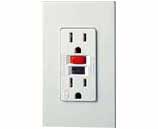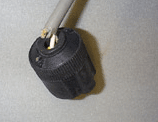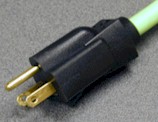|
|
Employers have the primary
responsibility for protecting the safety and health of their
workers. Employees are responsible for following the safe work
practices of their employers.
Consider implementing recommended safe work practices,
including those discussed here.
|
According to the National Institute for
Occupational Safety and Health (NIOSH) most electrical hazards can be eliminated
through safeguards and safe work practices such as:
- Use ground fault circuit interrupters (GFCIs) of the breaker or
receptacle type be installed in situations where electricity and
wetness coexist. GFCIs will interrupt the electrical circuit
before current sufficient to cause death or serious injury has
passed through a body. GFCIs are inexpensive ($50-$85 for
breaker type, $25-$45 for receptacle type) and a qualified
electrician can install them in existing electrical circuits
with relative ease.
|

Outlet with GFCI. |
- Employers should use ground-fault circuit interrupters (GCFIs)
on all 120-volt, single-phase, and 15- and 20-ampere receptacles.
- Wear and tear on electrical equipment or tools can result in
insulation breaks, short-circuits, and exposed wires. If there is
no ground-fault protection, these can cause a
ground-fault that sends current through the worker's
body, resulting in electrical burns, explosions, fire, or death.
- The GFCI is a
fast-acting circuit breaker designed to shut off electric power
in the event of a ground-fault and prevent injury to the worker.
|

Improper Use of Extention and Flexible Cords. Improperly wired and potentially dangerous use of extension cords - no GCFI. |
- Ensure that exposed receptacle boxes be made of nonconductive material
so that contact with the box will not constitute a "ground."
- Use plugs and receptacles designed to prevent energization
until insertion is complete.
- Ensure that all circuit breaker or fuse boxes bear a label for each
circuit breaker or fuse that clearly identifies its
corresponding outlets and fixtures. Also, breaker switches
should not be used for on-off switches.
- Inform all workers, when hired, of electrical hazards
and of safe work practices by which to avoid these hazards.
Workers should be informed that, in the event of an electrical
injury, no contact should be made with the victim or the
electrical apparatus causing the injury until the current has
been shut off.
- Encourage workers in restaurants to train in CPR.
|
Follow OSHA Standards including:
1910 Subpart S - Electrical some highlights include:
- Electrical equipment shall be free from recognized hazards
[29 CFR 1910.303(b)(1)].
- Listed or labeled equipment shall be used or installed in
accordance with any instructions included in the listing or
labeling [29 CFR 1910.303(b)(2)].
- Sufficient access and working space shall be provided and
maintained around all electric equipment to permit ready and
safe operation and maintenance of such equipment [29 CFR 1910.303(g)(1)].
- Ensure that all electrical service near sources of water is
properly grounded [29
CFR 1910.304(f)(5)(v)].
|

Damaged Cord. Damaged cords should not be used. |
- Tag out and remove from service all damaged receptacles and
portable electrical equipment [29 CFR 1910.334(a)(2)(ii)].
- Repair all damaged receptacles and portable electrical
equipment before placing them back into service [29 CFR 1910.334(a)(2)(ii)].
- Ensure that employees are trained not to plug or unplug
energized equipment when their hands are wet [29 CFR 1910.334(a)(5)(i)].
Additional Information:
|

Extension Cord with 3-Prong. Use grounded plug with properly grounded outlet. |

